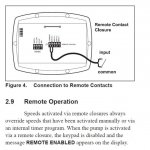New here. I'm looking to remove my tablet feeder and replacing with a SWG. My question is that I know it needs to run when the pump runs but how can I hook this up so it does that. This will be the second year of a new pool. Went with the tablet feeder the builder put in with the thought of "see how the year goes" to see if we want to replace it with a SWG. After seeing CYA go high because of Trichlor, decided to self install the SWG next month.
I can't seem to find much about where I can hook up the SWG to run with the pump. The pump is a Jandy VS 2.7 with a standard digital controller. During the season I had it run 24/7 on 50% unless we wanted water features, so the SWG would not be a problem then. During winter I run it nightly from 11p-7a to keep the water filtered. All I can find for the SWG is tying into the power on the time clock but my pump does not run on the standard time clock although there is still one there.
Any help would be greatly appreciated.
Thanks in advance.
This is the controller I have for the pump:
http://www.zodiac.co.za/admin/Content/cms/za-content/FloPro%20ePump%20Instruction%20Manual.pdf
I can't seem to find much about where I can hook up the SWG to run with the pump. The pump is a Jandy VS 2.7 with a standard digital controller. During the season I had it run 24/7 on 50% unless we wanted water features, so the SWG would not be a problem then. During winter I run it nightly from 11p-7a to keep the water filtered. All I can find for the SWG is tying into the power on the time clock but my pump does not run on the standard time clock although there is still one there.
Any help would be greatly appreciated.
Thanks in advance.
This is the controller I have for the pump:
http://www.zodiac.co.za/admin/Content/cms/za-content/FloPro%20ePump%20Instruction%20Manual.pdf
Last edited:



